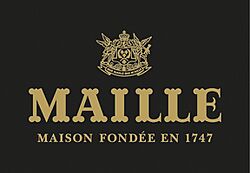Maille (company) facts for kids
Maille is a famous brand that makes tasty condiments like mustard and cornichons (small pickles). It started in Marseille, France, way back in 1723, making vinegar. Today, Maille is part of a big company called Unilever. They make Maille mustard in different places around the world. They also sell other products like salad dressings, cooking oils, and even kitchen gifts.
You can find Maille products in stores everywhere, and they've been selling online since 2007. Maille also has special shops called Maison Maille. These shops sell classic dijon mustard and mustards with unique flavors. You can find these shops in cities like Dijon, London, New York City, Paris, and Bordeaux. They also have smaller sections inside stores in Chicago, Portland, and San Francisco.
Maille mustard sold in America is made in Canada. But the Maille mustard sold in Canada comes all the way from France! Maille products from France are also sent to other countries in Europe, like Poland, and even to places like Singapore and Australia.
Contents
The History of Maille
How Maille Began
The Maille story started in 1723 with a vinegar maker in France. His son, Antoine-Claude Maille, opened a special shop in Paris in 1747. It was called La Maison Maille. He became a supplier to the royal court of King Louis XV. His father, also named Antoine-Claude, was known for suggesting vinegar as a treatment during the plague in the 1720s.
Becoming a Royal Supplier
Maille became very popular with royal families. In 1760, Maille was named the official vinegar supplier to the courts of Austria and Hungary. Later, in 1769, King Louis XVI of France gave him a special license. Two years after that, he received a charter to be the distiller and vinegar maker for Empress Catherine II of Russia.
New Owners and Royal Connections
Antoine-Claude Maille sold his business in 1800 and passed away in 1804. His son, Robert, later partnered with the son of the new owner in 1819. They continued to supply products to kings. They became the sole suppliers to King Louis XVIII in 1821. Maille also became the vinegar maker for Charles X in 1826, the King of England in 1830, and King Louis-Philippe in 1836. A new Maille shop opened in the Burgundy region of France in 1845.
Maille's Modern Era
In 1885, a company called Grey Poupon bought Maille. Then, in 1930, a businessman named Baron Philippe de Rothschild bought Maille. The company's famous slogan, Que Maille qui m’aille, which means "Maille alone suits me," was created in 1931. In 1936, Maille even advertised by spelling out its name in lights on rooftops in Paris! These big campaigns stopped when World War II began.
In 1952, Rothschild sold the brand to André Ricard and Joseph Poupon. Maille and Grey Poupon then started working together and selling their products in supermarkets.
Recent Milestones
The company started making Maille whisky glasses in 1988. A year later, they launched their special Fleur de Lys jar, which is still famous today. They began selling balsamic vinegar in 1991.
In 1996, Maille celebrated its 250th birthday! To mark the occasion, they opened a new shop in Paris. This shop sells packaged mustards, oils, and vinegars. It also offers fresh mustard straight from a pump, which is a unique experience.
Maille was sold to a company called Paribas Affaires Industrielles in 1997. Then, in 2000, Unilever bought Maille. In 2011, the company introduced new products. These included a Dijon mustard made with Chablis called "1747," an aged balsamic vinegar, and a black truffle mustard.
Maille Products
What is Dijon Mustard?
In 1937, the city of Dijon was given a special right called an Appellation Controlee. This means that for a mustard to be called "Dijon mustard," it must follow specific rules about how it's made. This helps ensure its quality and tradition.
Unique Flavors
Maille is known for making mustards and other condiments with many different ingredients. They have used flavors like mango, red berries, tarragon, and even Cognac.
In 1996, Maille started offering special, limited-edition mustards. These were served fresh from porcelain pumps, and each one featured a unique ingredient like Chablis. Some of these included a black truffle and Chablis mustard, served in beautiful sandstone jars.


